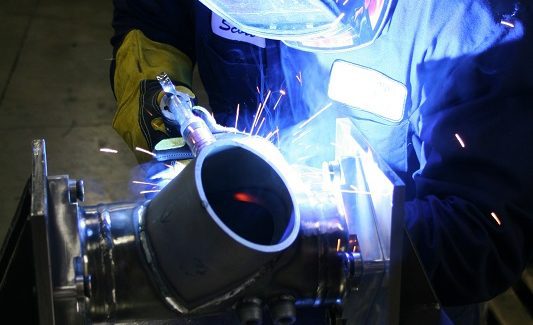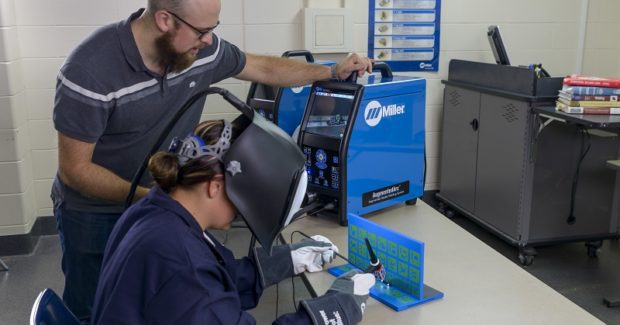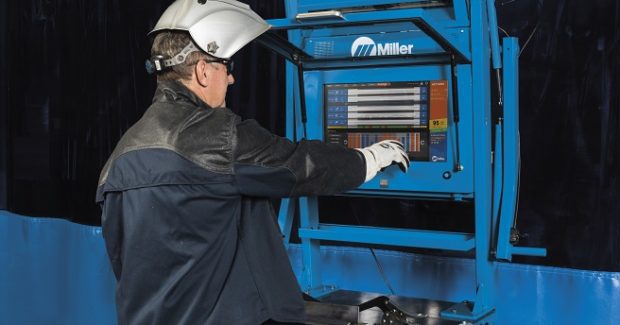Three Ways to Address the Welder Shortage
A lack of skilled labor may mean missed deadlines, a reduced ability to compete for jobs, higher costs and lost productivity due to rework. But new technologies and welding systems being designed by welding equipment manufacturers can help fabricators address these challenges, bridge the labor gap and remain competitive by completing jobs on time with high quality.
Posted: April 10, 2018
The welding operator shortage is being felt across all industrial sectors, from fabrication and construction to manufacturing. That’s not surprising, given that the American Welding Society (AWS; Miami, FL) estimates there will be a shortage of nearly 400,000 welding operators in the industry by 2024. The impact of this shortage can play out in many ways: A lack of skilled labor may mean missed deadlines, a reduced ability to compete for jobs, higher costs and lost productivity due to rework. Fortunately, there are now technologies and systems being designed by welding equipment manufacturers to help fabricators address these challenges and bridge the labor gap.
NO. 1: WELDING EQUIPMENT THAT’S EASIER TO USE
Think about your own daily life. When something is easier to use, whether it’s a smartphone or a website, it takes you less time to complete the task. The same holds true for welding equipment. More welding power sources today are designed with intuitive interfaces that allow the operator to make changes quickly and easily – often with only the push of a button – helping to improve productivity and saving time and money. An easier-to-use machine also helps shorten the training time for inexperienced welding operators so that they can get on the job faster. It can also impact weld quality in an operation. Many machines designed for simple use also make it easier for operators to choose the correct settings and parameters for the application. Some welding systems help operators with setup based on the type and thickness of material being welded to ensure that the correct parameters are used.
NO. 2: ADVANCED WELDING ARCS
Modern welding equipment can help improve productivity and weld quality for operators of various skill levels. Some welding power sources use advanced arc technology to precisely control the arc, which helps to produce high quality welds across a broader range of operator skill levels. Large industrial manufacturing operations, such as automotive and heavy equipment, were among the first to implement more advanced arc technology into their operations. But now these advanced arcs are becoming more accessible across welding equipment used in nearly all sectors of the welding industry, and they can be especially beneficial for welding lightweight, high-strength materials.
One example of this is the wider operating window of pulsed MIG (GMAW-P) options that makes the process more forgiving of operator variations in electrode extension, travel angle, travel speeds and other factors. These arcs are more adaptive in nature, so the welding power supply can compensate better for physical variations without a negative impact on weld quality, making it easier for less experienced operators to produce quality welds more consistently. This also holds true with the Regulated Metal Deposition (RMDÒ) welding process for pipe welding root passes.
NO. 3: TOOLS FOR TRAINING AND ASSESSMENT
Several training and assessment systems are available that offer benefits for welding operators who are new to the profession, as well as experienced operators already on the job. Virtual, augmented reality and welding simulation systems help speed up welder screening and training. Users can simulate MIG, TIG, flux-cored and stick welding processes with systems that are available today. Augmented reality provides a realistic welding simulation that closely resembles live arc welding by blending real-world and computer-generated images. Operators see this on a screen, allowing them to view it and react. These systems help shops save time and money in training because they don’t consume coupons, wire or gas, but to the user it looks and sounds like actual welding, complete with metal workpieces, welding arcs and weld beads. Welding training systems also reinforce proper technique and speed up skill development by delivering real-time feedback to help correct errors.
Another training system, such as our LiveArc™ welding performance management system, allows monitoring and feedback of operator technique to occur while real welding is happening. This type of system also gives instructors or trainers the flexibility to input parameters for a large number of welding joint configurations, which means welding operators can be measured on how they perform a weld to specific welding procedures. These types of technology are a great way to generate interest in welding from a new generation of applicants who grew up using smart technology. Additionally, technology that provides welding data and feedback can also be used once trained welding operators are on the job. Welding information management systems allow fabricators to conduct ongoing assessment and training with their labor force. These systems can provide data on many factors, including quality metrics, productivity and arc-on time, helping companies identify continuous improvement targets across their welding operation.
USING TECHNOLOGY TO ADDRESS THE WELDER SHORTAGE
The welding operator shortage has left many shops struggling to find enough skilled welders to fill jobs, while other fabricators may be seeing increased costs and rework due to less-experienced operators coming into the trade. New technologies and welding equipment that’s easier to use are keys to addressing these challenges so that manufacturers can remain competitive by completing jobs on time with high quality.


















